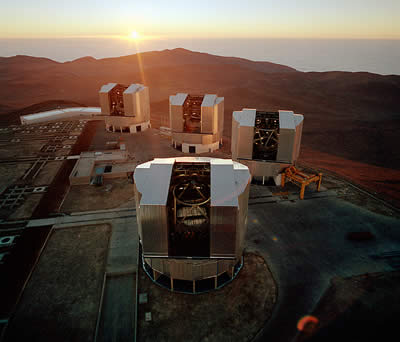observatory

The Very Large Telescope, built by the European Southern Observatory in Chile. It is one of the world's most important observatories.
An observatory is a site, building, or orbiting platform from which astronomical measurements are, or were formerly, made, or the administrative center for such work. Equipment at most observatories detects electromagnetic radiation in some particular band and, except for large radio antennae, is usually housed in a protective dome or similar structure.
History of observatories
Even before the invention of the telescope, observatories were built to measure the positions and movements of the Sun, Moon, planets, and stars. Ancient observatories, such as Stonehenge, were used to predict solstices and equinoxes. With Tycho Brahe (1546–1601) and the invention shortly after his death of the telescope, the modern observation had its roots.
Later, observatories, often on the outskirts of major cities such as Paris and London, used optical telescopes for more precise work in spherical astronomy and astrometry, and to investigate the nature of celestial objects, including those too faint to see with the naked eye. As telescopes increased in size, magnifying the turbulent effects of the atmosphere, the importance of clear, high-altitude observing sites grew.
Modern observatories
Large optical and infrared instruments are now always set up in locations that studies have shown to have the driest, most transparent skies on the planet, including ones in Chile, the Canary Islands, and Hawaii. Radio telescopes and interferometers in the meter and centimeter are less susceptible to atmospheric conditions than they are to interference from artificial radio sources, although those working at millimeter and, especially, submillimeter wavelengths suffer from atmospheric absorption are often placed on mountaintop locations alongside their optical and infrared counterparts.
Equipment designed to observe the universe at short wavelengths, including ultraviolet, X-rays, and gamma rays, and in much of the infrared band, must be flown above most or all of the atmosphere aboard balloons, sounding rockets, aircraft, or, most effectively, spacecraft. Beyond the electromagnetic spectrum, instruments and observatories have been specially designed to detect cosmic rays and neutrinos, and to search for (as yet undetected) gravitational waves.


